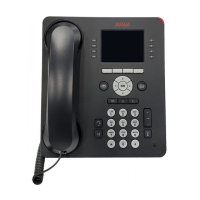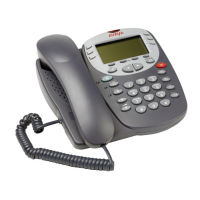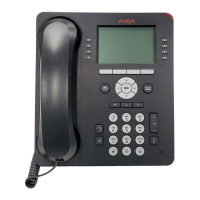
Do you have a question about the Avaya IP Office Basic Edition and is the answer not in the manual?
| Model | IP Office Basic Edition |
|---|---|
| SIP Trunking | Yes |
| Protocols | SIP, H.323 |
| Auto Attendant | Yes |
| Mobility | Optional |
| Display | Varies by handset model |
| Lines | Varies by handset model |
| Weight | Varies by handset model |
| Dimensions | Varies by handset model |
| Voicemail | Optional (Voicemail Pro) |
| Call Recording | Optional |
| Memory Buttons | Varies by handset model |
| Speakerphone | Varies by handset model |
| Headset Port | Varies by handset model |
| Power over Ethernet (PoE) | Varies by handset model |
Lists the settings that can be programmed from a suitable phone on the first two extensions in the system.
Details about assigning functions to programmable buttons on supported phones.
Covers the 1400 Series and 9500 Series phones supported by the IP Office Basic Edition system.
Summarizes the Admin menu options provided by phones using DS ports.
Describes system and extension programming using ETR phones.
Covers M-Series and T-Series phones supported by the IP Office Basic Edition system.
Details the differences and configurations between Key System and PBX System modes.
Explains how outgoing calls are routed in Key System and PBX System modes.
Describes how incoming calls are presented and routed in Key System and PBX System modes.
Details extension numbering and special dialed numbers.
Explains how calls are handled when they go to a user's mailbox or an auto attendant.
Details the setup and functionality of the Night Service feature.
Configures the system to operate in either key system mode or PBX system mode.
Sets whether the system uses 2-digit or 3-digit extension numbering.
Sets the locale (country) for system settings and default language.
Determines the number of outside lines automatically assigned to buttons on all extensions.
Allows individual setting of additional lines to line appearance buttons.
Sets the extension to which incoming calls are presented if unanswered.
Allows assigning a line to a different auto attendant.
Sets the date displayed on phones and used by the system.
Sets the time displayed on phones and used by the system.
Automatically updates system date and time using service provider information.
Specifies telephone numbers that extensions can dial, overriding other restrictions.
Stores up to 10 emergency numbers accessible by all users.
Specifies types of outgoing calls allowed on all lines at an extension.
A four-digit password to override dialing restrictions or control access to features.
Groups lines to create destinations for outgoing external calls.
Defines call types and associated ARS selectors for routing.
Configures doorphone extensions and alert extensions.
Enables the use of contact closure devices like door locks.
Specifies the extension connected to the loudspeaker paging system.
Configures up to 100 frequently dialed numbers for all users.
Allows each extension to have up to 20 personal speed dials.
Programs extensions to log answered and unanswered Caller ID calls.
Assigns a name to an extension for display during calls.
Enables call waiting tones for a single-line extension.
Sets the extension to automatically dial an external number when off hook.
Sets the extension to automatically dial another extension when off hook.
Sets numbers that can still call an extension when Do Not Disturb is enabled.
Creates a list of account codes used to verify entries by extension users.
Sets which extensions must enter an account code before making outside calls.
Switches the use of voicemail coverage for an extension on or off.
Sets the number of times an extension rings before going to voicemail.
Allows users to set or reset an access code for their voicemail.
A group of extensions that can be called simultaneously.
Incoming calls hunt through group extensions for the first available answer.
Allows users to answer calls ringing within the group.
Incoming calls ring only once when the user is on another call.
Defines the number of rings before calls are sent to the covering extension.
Sets ringing behavior (immediate, delayed, or no ring) for a line appearance.
Allows extension's ring pattern to override line ringing settings.
Specifies what callers hear while being transferred.
Sets how long a call remains on hold before recalling to the originating extension.
Enables music played to callers placed on hold.
Lists and describes various functions assignable to phone buttons.
Allows users to enter an account code before making calls.
Switches call coverage for an extension on or off.
Redirects all calls to another number or extension.
Allows users to answer a call alerting at a specified extension.
Prevents incoming calls from ringing at the extension.
Allows users to call or page a hunt group.
Allows users to seize an idle line without a line appearance button.
Makes a page call to the configured loudspeaker extension.
Allows users to answer calls ringing within a pickup group.
Turns privacy on or off, preventing others from bridging into calls.
Saves a dialed number to redial when idle.
Locks the extension from making calls.
Switches voicemail coverage for the extension on or off.
Copies settings from one extension to another of the same type.
Changes the password for PC access to system configuration settings.
Performs a manual backup of the current system configuration.
Restores the system configuration from a previous backup.
Resets the system and returns configuration to default settings.
Resets the system while retaining programmed settings.
Shuts down the system for maintenance.
Copies new software to the system SD card.
Displays system information for troubleshooting.











